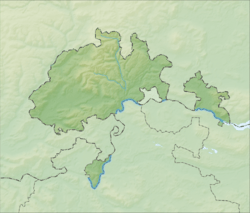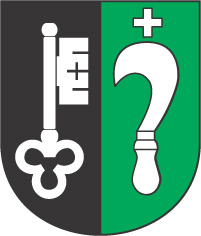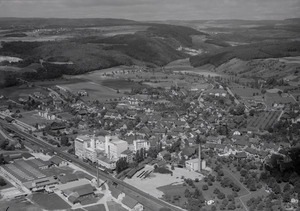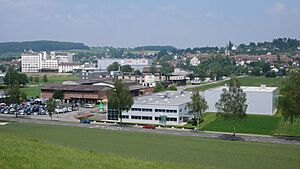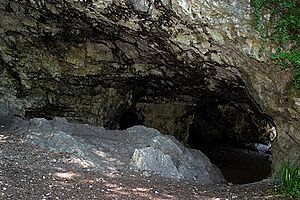Thayngen facts for kids
Quick facts for kids
Thayngen
|
||
|---|---|---|
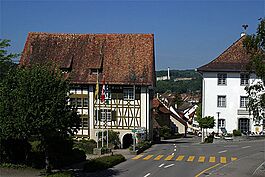 |
||
|
||
| Country | Switzerland | |
| Canton | Schaffhausen | |
| District | n.a. | |
| Area | ||
| • Total | 19.92 km2 (7.69 sq mi) | |
| Elevation | 437 m (1,434 ft) | |
| Population
(Dec 2020 )
|
||
| • Total | 5,608 | |
| • Density | 281.53/km2 (729.15/sq mi) | |
| Postal code |
8240
|
|
| Surrounded by | Bibern, Dörflingen, Gottmadingen (DE-BW), Hilzingen (DE-BW), Lohn, Schaffhausen, Stetten | |
Thayngen is a village and a town in the Schaffhausen canton of Switzerland. It's a small but important place. Over the years, several nearby villages have joined with Thayngen. Barzheim became part of Thayngen in 2004. Then, in 2009, Altdorf, Bibern, Hofen, and Opfertshofen also merged with Thayngen.
Contents
Geography of Thayngen
Thayngen covers an area of about 11.9 square kilometers (4.6 square miles). A large part of this land, about 52%, is used for farming. Forests cover almost 29% of the area. Around 17% of the land has buildings or roads. The rest, a small part, is made up of rivers or lakes.
Lakes in Thayngen
Thayngen is home to two special small lakes called kettle ponds. These are the Morgetshofsee and the Rudolfersee. Kettle ponds are formed when blocks of ice from glaciers melt, leaving a hollow in the ground that fills with water.
Thayngen's Coat of Arms
The official design of Thayngen's coat of arms is quite interesting. It shows a shield split into two parts. On the left side, which is black, there is a silver key. On the right side, which is green, there is a silver sickle (a tool used for cutting crops). At the very top, there is a silver cross.
People and Population
As of 2008, Thayngen had a population of 4,935 people. About 17.8% of these people were from other countries. Many of the foreign residents came from Germany, Italy, Croatia, Serbia, Macedonia, and Turkey.
Languages Spoken
Most people in Thayngen speak German, which is the main language for about 90% of the population. Italian is the second most common language, spoken by about 3% of residents. Serbo-Croatian is the third most common language.
Age Groups
The population of Thayngen is divided into different age groups. Children and teenagers (from birth to 19 years old) make up 20% of the population. Adults (from 20 to 64 years old) are the largest group, making up 61.1%. Seniors (people over 64 years old) make up 18.9% of the population.
Education in Thayngen
Many adults in Thayngen have completed a good level of education. About 73% of people aged 25-64 have finished either a non-mandatory upper secondary education or even higher education, like university. In 2007, a small percentage of children attended kindergarten or pre-school. More children attended primary school, and then lower and higher secondary schools.
Religious Beliefs
In 2000, most people in Thayngen belonged to the Swiss Reformed Church, which is a Protestant church, making up 57.1% of the population. About 22.6% of the population belonged to the Roman Catholic Church.
Population Changes Over Time
The number of people living in Thayngen has changed over the years. Here's a quick look:
| year | population |
|---|---|
| 1990 | 4,726 |
| 2000 | 4,813 |
Economy and Jobs
Thayngen has a low unemployment rate, meaning most people who want to work can find jobs. In 2005, there were many businesses and jobs across different areas.
Types of Jobs
- Primary Sector: This includes jobs related to farming and natural resources. About 212 people worked in this area, with around 50 businesses.
- Secondary Sector: This involves manufacturing and construction. About 1,342 people worked in this sector, with 54 businesses.
- Tertiary Sector: This covers services like shops, offices, and healthcare. About 912 people worked here, with 132 businesses.
Most working people in Thayngen are employed full-time. Many residents also travel outside Thayngen for work, and many people from other places come into Thayngen to work.
Tourism and Hospitality
Thayngen also has a small but active hospitality industry. In 2008, there were 9 restaurants and 3 hotels, offering 31 beds for visitors. This sector employed 46 people.
Important Historical Sites
Thayngen has several places that are very important to Swiss history and culture. These are called heritage sites of national significance.
Historic Buildings
Two houses in the town are especially important:
- The Haus zum Hirzen located at Schulstrasse 3.
- The Haus zum Rebstock located at Im Oberhof 4.
Prehistoric Sites
Thayngen is also home to two very old prehistoric sites:
- The Kesslerloch: This was a cave where people lived during the Paleolithic period, which was the Old Stone Age.
- The Weier: This was a settlement along a river bank during the Neolithic period, or New Stone Age. The settlements at Weier I-III are part of the Prehistoric Pile dwellings around the Alps. This is a special group of ancient sites that are recognized as a UNESCO World Heritage Site, meaning they are important to the whole world.
Transportation in Thayngen

Thayngen has its own Thayngen railway station. This station is part of the Zurich S-Bahn network, which connects Thayngen to Zurich and Bülach. It also has regional train services that link Schaffhausen to Singen in Germany.
The border with Germany is very close to Thayngen. This border crossing is often busy, especially with trucks traveling between Germany and Switzerland.
See also
 In Spanish: Thayngen para niños
In Spanish: Thayngen para niños




